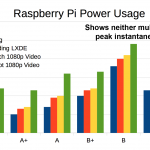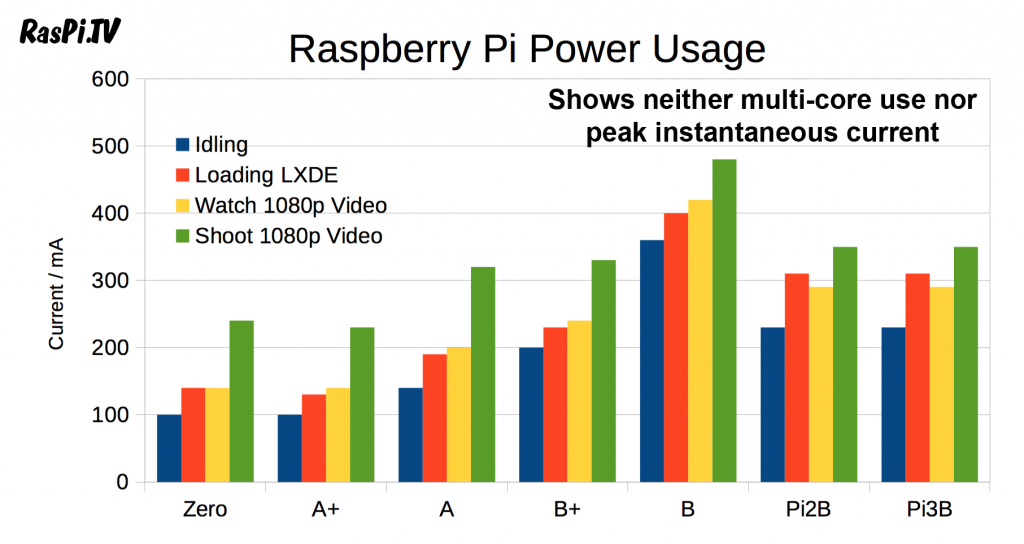May 202016

It’s only a few days since the Pi Zero 1.3 came out, but people are already asking for me to “fill in the gap” on my power chart. Which gap? The “Pi Zero shooting 1080p video” gap. With no camera port, the previous Pi Zero couldn’t do this, so there was no measurement to report. I’ve made some measurements this morning and here are the results…
No Real Surprises
I tried both old and new cameras and there wasn’t any significant difference (that I could measure) between them. The results are comparable to that of the A+, which is hardly surprising. Even though slightly higher, I’d call it the same within experimental error.


Hi there,
love your website and work. Where can I get the pi zero? Seems all the usual, modmypi, pihut and pimoroni are constantly sold out… :(
Pihut and Pimoroni had stock in for several hours on Monday this week. That’s way longer than normal. It is expected that there will be regular batches now. Even when the bare Pi Zeros are sold out, you can usually manage to snag one of the kits. I’ve managed to buy them from Pimoroni and the Pi Hut on more than one occasion.
http://stockalert.alexellis.io/ is useful ;-)
You gotta update the family photo now…
LOL. All in good time.
Thanks a lot for the measurements.
Hey Alex, first I have to say the blog posts are great! Do you accept donations?
2nd, do you have any information on peak instances or are you unable to measure it?
I am thinking about running a pi 2 or 3 via PoE in my house, as a security cam with this injector (http://www.ebay.com/itm/like/182218576621?lpid=82&chn=ps&ul_noapp=true)
The concern is not the voltage, but the max. amps I can get to the device to run the raspi_cam and send it over the network.
I know you mentioned something about this in your other post (https://raspi.tv/2016/how-much-power-does-raspberry-pi3b-use-how-fast-is-it-compared-to-pi2b)
Cheers,
Bob
Hi Bob
I don’t have a donations button, but if you’d like to have a look over at https://rasp.io you might find some useful Pi related hardware. That’s how I make my living these days :)
I still haven’t had a chance to play with my oscilloscope and work this out (peak instances)
Thanks for the quick reply Alex. I am just worried about the device shutting off if it does not have enough juice. I will take a look over at rasp.io
You may find some of the information at https://www.raspberrypi.org/help/faqs/#power useful :-)
I’m going to be working on a project with a quad copter and I was curious if shooting video vs taking a single picture would use the same power or not; as I’ll only have 750 mAh lipo battery, knowing how long I have would help
Taking a single shot would most likely use the same power but for a shorter time, so overall less – unless you were shooting almost the whole time.
So that we can use one set of consistent power measurements, do you have power figures when the camera not connected ? Have you tried switching the camera power on and off, using an external switch of course ? Does camera power vary with frame rate ? What is LDXE ?
To answer your first question, Yes. The non-camera measurements are done that way.
Your second question displays lack of knowledge on how the Pi camera is attached (ribbon cable). There is no way to switch it.
As far as frame rates are concerned, that’s not something I’m going to get into. My standardised test is shooting 1080p video. It’s an indication, which was chosen to MAXIMISE the current consumption and give a “worst-case scenario” which makes it a good one.
If you want anything more specific or in-depth, you’ll have to measure it yourself. Any moving of the goal-posts at this stage would mean a set of measurements for all 7 major variants tested.
LXDE info can be found here https://lmgtfy.com/?q=lxde
Well for what it’s worth i’m using a Pi zero W with LiPo Pimoroni hat and a camera streaming video (built on top of an old remote car of my son) to a web page on my local network so that i can “drive” the car from behind my PC. It lasts only 45 minutes on a 1200mAh LiPo battery…. How’s that for power consumption !!